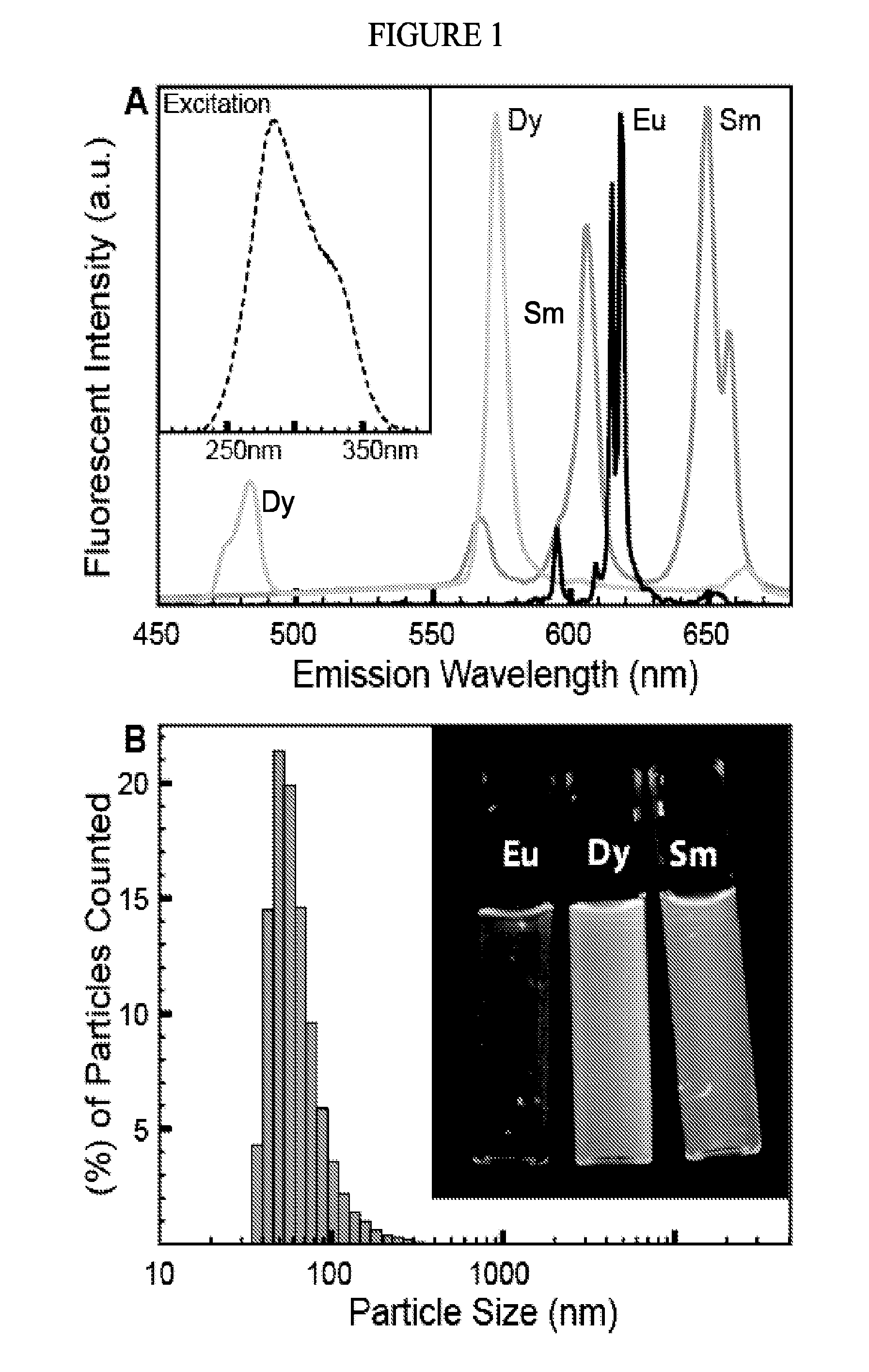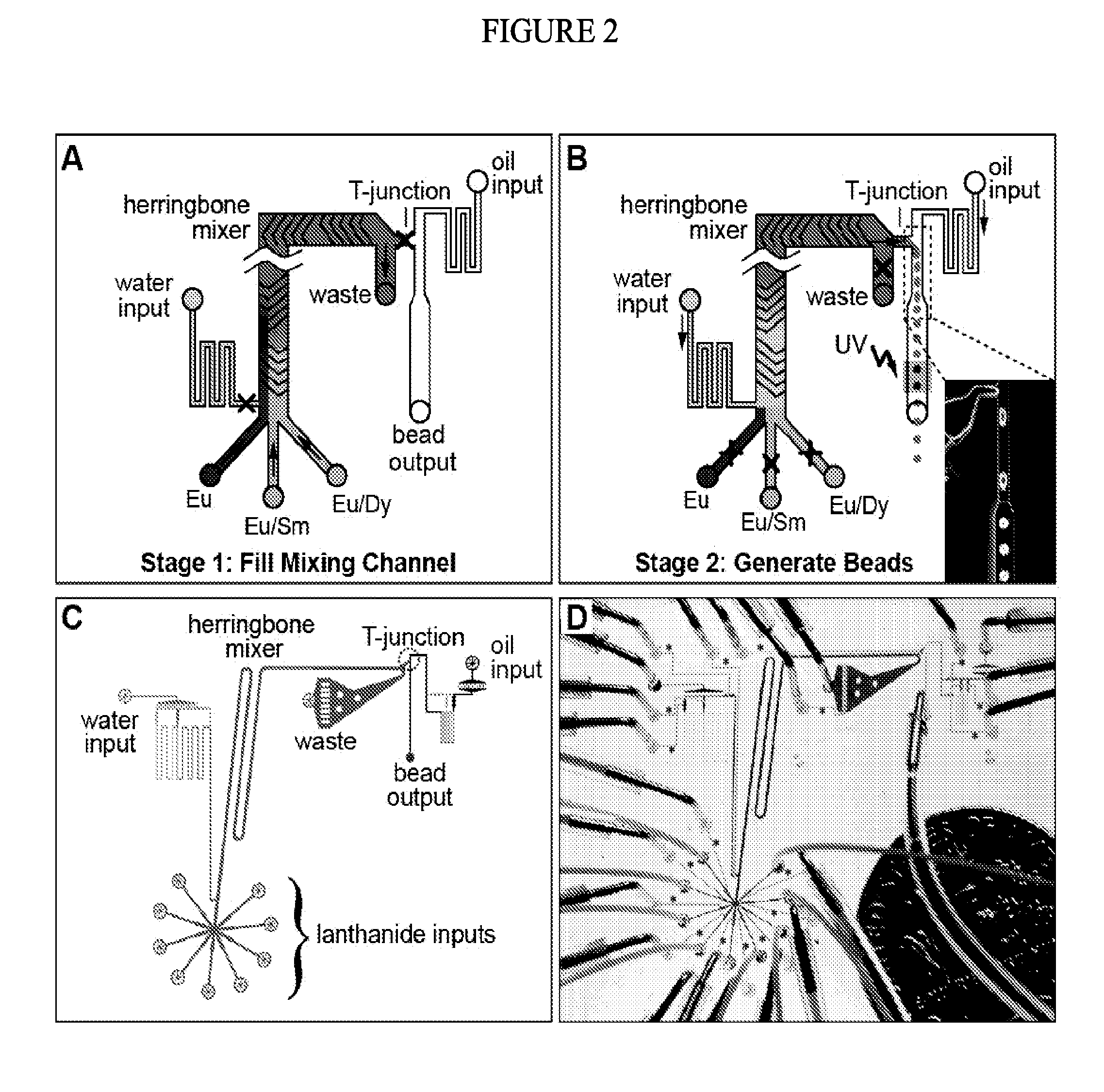Spectrally encoded microbeads and methods and devices for making and using same
a technology of microbeads and encoding methods, applied in the field of spectrally encoded microbeads and methods and devices for making and using same, can solve the problems of limited practical application of bead encoding to date, new approaches are needed, and few practicable cost-effective assays for multiplexing exist. to achieve the effect of facilitating preparation and us
- Summary
- Abstract
- Description
- Claims
- Application Information
AI Technical Summary
Benefits of technology
Problems solved by technology
Method used
Image
Examples
example 1
Synthesis of Lanthanide Nanoparticles
[0176]Nanoparticles for use in preparation of the disclosed spectrally encoded microbeads were synthesized using a polymer-assisted hydrothermal approach combined with microwave irradiation. Chemical reagents and polymers [poly(ethylene glycol) (PEG) and poly(acrylic acid) (PAA)] for nanoparticle synthesis were purchased from Sigma-Aldrich (St. Louis, Mo.) and were used without further purification. Microwave synthesis was performed using a Biotage Initiator (Biotage AB, Uppsala, Sweden). Purification of the synthesized nanoparticles was performed by ultrafiltration using Amicon Ultra-15 centrifugal filter units with a 50,000 Dalton Molecular Weight Cutoff (MWCO) (Millipore, Billerica, Mass.), resulting in suspensions with a nanoparticle concentration of ˜50 mg / mL in water. Luminescence spectra were measured using a FluoroMax-3 (Horiba Scientific, Kyoto, Japan) spectrofluorometer and the nanoparticle particle size distributions were measured usin...
example 2
Synthesis of Ratiometrically Encoded Polymeric Beads
[0179]Microfluidic Device Production
[0180]To incorporate the prepared lanthanide nanoparticles into solid beads at programmed ratios, a custom, fully-automated microfluidic device was designed and fabricated. Devices were fabricated in poly(dimethylsiloxane) (PDMS, RTV 615, Momentive Performance Materials, Albany, N.Y.) by Multi-Layer Soft Lithography using 4″ test-grade silicon wafers (University Wafer, South Boston, Mass.) coated with multiple layers of SU8 (Microchem Corp., Newton, Mass.) and AZ50 XT photoresists (Capitol Scientific, Austin, Tex.) patterned by standard photolithography processes.
[0181]All photolithography masks were designed using AutoCAD (Autodesk, San Rafael, Calif.) and printed onto transparency film with a resolution of 30,000 dpi (FineLine Imaging, Colorado Springs, Colo.). To improve adhesion of subsequent photoresist layers, all wafers were first coated with a 5 μm layer of SU-8 2005 negative photoresist ...
example 3
Imaging of Spectrally Encoded Beads
[0201]Microfluidic Device Production
[0202]To measure the lanthanide luminescence ratios in the spectrally encoded beads, an additional custom microfluidic device was developed to create an ordered linear array of ˜190 beads within a narrow serpentine channel (FIG. 3, Panel A) covering a ˜1 mm2 area. Beads in the serpentine can be loaded and unloaded using on-chip valves in the fluidic circuit, allowing for efficient imaging of large numbers of beads.
[0203]All photolithography masks were designed using AutoCAD (Autodesk, San Rafael, Calif.) and printed onto transparency film with a resolution of 30,000 dpi (FineLine Imaging, Colorado Springs, Colo.). To improve adhesion of subsequent photoresist layers, all wafers were first coated with a 5 μm layer of SU-8 2005 negative photoresist (Microchem Corp.) according to the manufacturer's instructions. All spin-coating steps were performed on a G3P-8 programmable spin coater (Specialty Coating Systems, Ind...
PUM
| Property | Measurement | Unit |
|---|---|---|
| diameter | aaaaa | aaaaa |
| diameter | aaaaa | aaaaa |
| diameter | aaaaa | aaaaa |
Abstract
Description
Claims
Application Information
 Login to View More
Login to View More - R&D
- Intellectual Property
- Life Sciences
- Materials
- Tech Scout
- Unparalleled Data Quality
- Higher Quality Content
- 60% Fewer Hallucinations
Browse by: Latest US Patents, China's latest patents, Technical Efficacy Thesaurus, Application Domain, Technology Topic, Popular Technical Reports.
© 2025 PatSnap. All rights reserved.Legal|Privacy policy|Modern Slavery Act Transparency Statement|Sitemap|About US| Contact US: help@patsnap.com



